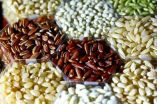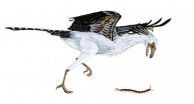(Press-News.org) AUSTIN, Texas — Scientists from The University of Texas at Austin and five other institutions have discovered that the more diverse the diet of a fish, the less diverse are the microbes living in its gut. If the effect is confirmed in humans, it could mean that the combinations of foods people eat can influence the diversity of their gut microbes.
The research could have implications for how probiotics and diet are used to treat diseases associated with the bacteria in human digestive systems.
A large body of research has shown that the human microbiome, the collection of bacteria living in and on people's bodies, can have a profound impact on human health. Low diversity of bacteria in the human gut has been linked to a plethora of diseases.
"There's been a lot of work done showing that what people eat influences what gut microbes they have, and that can affect risk of obesity, diabetes, heart disease and other things," said Daniel Bolnick, professor in The University of Texas at Austin's College of Natural Sciences and lead author of the study, published this week in the journal Ecology Letters.
Researchers have already established that environment and diet can all affect the kinds of bacteria that live in the human digestive system. Unfortunately, most studies on the effect of diet on the microbiome only look at one thing at a time -- such as a high-fat versus a low-fat diet.
Bolnick and his colleagues decided for the first time to look at the effect of combinations of different foods on gut bacteria. They used two species of fish, the threespine stickleback and the Eurasian perch, to model the human gut.
Populations of both fish were studied in the wild, where the fish typically dine on two major types of prey. The fish eat large insect larvae that live in the soil near the lakeshore, as well as small crustaceans that live in the open water far from shore. Since Because the individual fish vary in what they eat -- some feasting mainly upon on insect larvae, others favoring the small crustaceans and the rest feeding upon on a varying mixture of the two -- they proved to be perfect subjects for the study.
The scientists also manipulated the diet of a population of sticklebacks in the laboratory, feeding some on frozen insect larvae, others on tiny crustaceans, and a third group on an equal mixture of the two foods.
The researchers expected that the generalists, the fish dining upon on the mixed diet, would have more diversity in their gut microbes than the fish that specialized in one type of prey. Since Because the mixed diet would expose the fish to a larger variety of microbes and their guts would hold a more diverse buffet for the microbes to munch on, it seemed a logical conclusion.
The researchers found the opposite to be true: the The fish that favored one type of food item had more bacterial diversity in their guts than fish that ate a mixture of prey.
The authors have suggested some possible explanations for these results. It could be that the larger diversity of foods in the gut gave an advantage to some generalist bacteria, allowing them to thrive at the expense of more specialized bacteria. They found that one strain of bacteria dominated the guts of stickleback that ate a larger variety of prey, supporting this concept. Another possibility is that the prey items give off an inhibitory chemical that suppresses certain bacteria. If the fish ingest a variety of prey, and thus multiple inhibitors, then fewer gut microbes would survive. These hypotheses still need to be rigorously tested.
One thing is clear though. If these results translate to humans, then scientists may have to rethink how they study the effects of different foods on the human microbiome.
"Our results suggest that what we know about diet effects really has to change to account for mixing of things, because humans don't eat just one thing at a time," said Bolnick. "The effect of a mixed diet isn't easily deduced from the two diets separately. The whole is less than the sum of its parts."
INFORMATION:
Bolnick's co-authors include are Lisa Snowberg (UT Austin), Philipp Hirsch (University of Basel and Uppsala University), Christian Lauber and Rob Knight (University of Colorado, Boulder), J. Gregory Caporaso (Northern Arizona University and Argonne National Laboratory), and Richard Svanbäck (Uppsala University).
This research was funded by the Howard Hughes Medical Institute, the David and Lucille Packard Foundation, and the Swedish Research Council.
You can read the original study, "Individuals' diet diversity influences gut microbial diversity in two freshwater fish (threespine stickleback and Eurasian perch)" here: http://doi.wiley.com/10.1111/ele.12301
Variety in diet can hamper microbial diversity in the gut
2014-05-28
ELSE PRESS RELEASES FROM THIS DATE:
Melting Arctic opens new passages for invasive species
2014-05-28
For the first time in roughly 2 million years, melting Arctic sea ice is connecting the north Pacific and north Atlantic oceans. The newly opened passages leave both coasts and Arctic waters vulnerable to a large wave of invasive species, biologists from the Smithsonian Environmental Research Center assert in a commentary published May 28 in Nature Climate Change.
Two new shipping routes have opened in the Arctic: the Northwest Passage through Canada, and the Northern Sea Route, a 3000-mile stretch along the coasts of Russia and Norway connecting the Barents and Bering ...
3,000 rice genome sequences made publicly available on World Hunger Day
2014-05-28
The open-access, open-data journal GigaScience (published by BGI and Biomed Central), announces today the publication of an article on the genome sequencing of 3000 rice strains along with the release of this entire dataset in a citable format in journal's affiliated open-access database, GigaDB. The publication and release of this enormous data set (which quadruples the current amount of publicly available rice sequence data) coincides with World Hunger Day to highlight one of the primary goals of this project— to develop resources that will aid in improving global food ...
High-status co-eds use 'slut discourse' to assert class advantage
2014-05-28
WASHINGTON, DC, May 27, 2014 — A new study suggests that high-status female college students employ "slut discourse" — defining their styles of femininity and approaches to sexuality as classy rather than trashy or slutty — to assert class advantage and put themselves in a position where they can enjoy sexual exploration with few social consequences.
"Viewing women only as victims of men's sexual dominance fails to hold women accountable for the roles they play in reproducing social inequalities," said lead author Elizabeth A. Armstrong, an associate professor of sociology ...
Prehistoric birds lacked in diversity
2014-05-28
Birds come in astounding variety—from hummingbirds to emus—and behave in myriad ways: they soar the skies, swim the waters, and forage the forests. But this wasn't always the case, according to research by scientists at the University of Chicago and the Field Museum.
The researchers found a striking lack of diversity in the earliest known fossil bird fauna (a set of species that lived at about the same time and in the same habitat). "There were no swans, no swallows, no herons, nothing like that. They were pretty much all between a sparrow and a crow," said Jonathan ...
Cod bones reveal 13th century origin of global fish trade
2014-05-28
London's international fish trade can be traced back 800 years to the medieval period, according to new research published today in the journal Antiquity.
The research, led by archaeologists from UCL, Cambridge and UCLan, provides new insight into the medieval fish trade and the globalisation of London's food supply.
Archaeologists analysed data from nearly 3,000 cod bones found in 95 different excavations in and around London. They identified a sudden change in the origin of the fish during the early 13th century, indicating the onset of a large-scale import trade.
Lead ...
Butterfly 'eyespots' add detail to the story of evolution
2014-05-28
CORVALLIS, Ore. – A new study of the colorful "eyespots" on the wings of some butterfly species is helping to address fundamental questions about evolution that are conceptually similar to the quandary Aristotle wrestled with about 330 B.C. – "which came first, the chicken or the egg?"
After consideration, Aristotle decided that both the egg and the chicken had always existed. That was not the right answer. The new Oregon State University research is providing a little more detail.
The study, published today in Proceedings of the Royal Society B, actually attempts to ...
Should sugary drinks carry a health warning?
2014-05-28
In a personal view published on bmj.com today, a professor of public health at a leading university thinks there should be health warning labels on sugary drinks.
Professor Simon Capewell, professor at the University of Liverpool, highlights that the State of California is considering a new health bill. One which will see sugary drinks labelled with health warnings, vending machines to bear warning labels, and fines of between $50 and $500 per failed inspection".
Professor Capewell thinks this is a good idea, and one that the UK public would support.
He says that ...
Higher NHS spending in deprived areas can reduce health inequalities
2014-05-28
A policy of higher NHS spending in deprived areas compared with affluent areas is associated with a reduction in absolute health inequalities from causes amenable to healthcare in England, suggests a study published on bmj.com today.
In 1999, the government introduced a new 'health inequalities' objective for the allocation of NHS resources in England, which resulted in greater NHS spending in deprived areas with the worst health outcomes. But it is not known whether this policy was successful in contributing to a reduction in health inequalities.
So researchers based ...
School scheme unable to boost healthy eating and activity among kids
2014-05-28
A school-based scheme to encourage children to eat healthily and be active has had little effect, conclude researchers in a study published on bmj.com today.
The findings have relevance for researchers, policy makers, public health practitioners, and doctors, and they suggest that more intense interventions may be required.
Low levels of physical activity and of fruit and vegetable consumption in childhood are associated with adverse health outcomes. School based interventions have the potential to reach the vast majority of children, and evidence reviews have suggested ...
Barriers to HIV testing in older children
2014-05-28
Concerns about guardianship and privacy can discourage clinics from testing children for HIV, according to new research from Zimbabwe published this week in PLOS Medicine. The results of the study, by Rashida A. Ferrand of the London School of Hygiene & Tropical Medicine and colleagues, provide much-needed information on how to improve care of this vulnerable population.
More than three million children globally are living with HIV (90% in sub-Saharan Africa) and in 2011 an estimated 1000 infant infections occurred every day. HIV acquired through mother-to-child transmission ...


